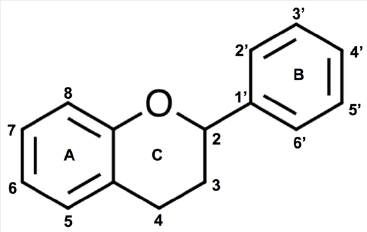 Flavonoids are low molecular weight polyphenols that occur ubiquitously in fruits, vegetables and other plant material. Chemically, flavonoids are phenylbenzopyrones which means they have a basic structure of a O-heterocyclic ring (B-ring) fused to an aromatic ring (C-ring) with a third ring system (A-ring) (figure 1). Over 6000 flavonoids have been identified and characterised, and a large number of these flavonoids are present in the human diet in the plant foods we eat. Important dietary flavonoids include quercetin, kaempferol, apigenin, chrysin, luteolin, naringenin and catechin. In plants these flavonoids are often bound to sugars and therefore exists as glycosides. This ring system makes them biological antioxidants, and it is this role for which they are best known. However, flavonoids have been shown to have other biological effects outside of their main antioxidant activity, and in particular a number of flavonoids are known to interact with receptor systems and elicit cellular changes.
Flavonoids are low molecular weight polyphenols that occur ubiquitously in fruits, vegetables and other plant material. Chemically, flavonoids are phenylbenzopyrones which means they have a basic structure of a O-heterocyclic ring (B-ring) fused to an aromatic ring (C-ring) with a third ring system (A-ring) (figure 1). Over 6000 flavonoids have been identified and characterised, and a large number of these flavonoids are present in the human diet in the plant foods we eat. Important dietary flavonoids include quercetin, kaempferol, apigenin, chrysin, luteolin, naringenin and catechin. In plants these flavonoids are often bound to sugars and therefore exists as glycosides. This ring system makes them biological antioxidants, and it is this role for which they are best known. However, flavonoids have been shown to have other biological effects outside of their main antioxidant activity, and in particular a number of flavonoids are known to interact with receptor systems and elicit cellular changes.

The heterocyclic ring structure of the flavonoids. Flavonoids have an A, B and C ring. These rings are slightly different for each flavonoid and this gives them unique physiological properties. The flavones apigenin and chrysin have structures that allows them to bind to the benzodiazepine receptor in the brain of mammals. This binding allows the flavonoids to cause behavioural changes that includes a reduction in the level of anxiety felt by the individual. Quercetin and kaempferol, two flavonoids belonging to the flavonol group of flavonoids, may also have similar properties.
The role of flavonoids at affecting the central nervous system activity of mammals is a more recent discovery. Evidence clearly shows that some flavonoids bind to the benzodiazepine receptor in the brain of mammals and this may cause behavioural changes. Both apigenin and chrysin belong to the flavone group of flavonoids and both have been shown to bind to the benzodiazepine receptor. This receptor binding may explain the anxiolytic (anti-anxiety) effects elicited by the compounds in animal experiments. Further, a number of herbs known for their anxiolytic effects are known to contain apigenin or chrysin. For example chamomile (Matricaria chamomilla) contains apigenin and passionflower (Passiflora incarnata) contains chrysin. The anxiolytic effects of these herbs are likely due to the interaction of the flavonoids with the benzodiazepine receptor. However, it is likely that the sedative effects are caused by another mechanism. Both herbs are therefore useful in the treatment of mild to moderate anxiety.
Eat Well, Stay Healthy, Protect Yourself
RdB
